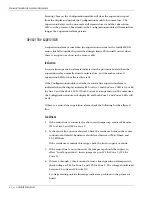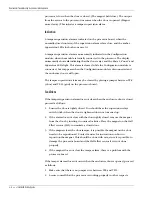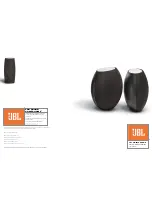
Maintenance/Troubleshooting - Detection problems
a - 8 • • • Intelli-FLEX II product guide
Be sure that the cables are connected center-to-center,
and shield-to-shield.
3. Switch the processor to Level mode on the Configuration module, and tap
the fence in the selected zone to obtain a level reading. If a level reading is
obtained, go to step 4. If a Level reading is not obtained and/or you do not
see a response when the fence is tapped, it is likely that the processor board
is defective. Repeat this step with a known good processor board to verify that
the problem is in the sensor cable.
4. Attach a high impedance input amplified speaker to the pre-amp test point for
the zone you are testing. (Contact Senstar for availability.) Compare the
sound of the zone that is not working properly with one that is for clues that
might lead to the cause of the problem.
When you have established that the sensor cable is providing a signal to the
processor, proceed with
on page 7 - 6. If the zone passes these tests proceed
Uneven detection profiles are often due to differences in fence fabric tension on
different panels of the fence, some differences may also be due variations in the
sensor cable installation. Some variation in response is normal and acceptable.
The preamplifier gain setting should be set just high enough to provide adequate
performance in the low response areas.
Be sure you have selected, and are monitoring the zone you are testing. The cut
count should decrease each time the fence is tapped. If this does not happen each
time, tap harder until the tap intensity required for detection is established. This
should not be excessive.
If you find that taps which produce a level reading above 20 are not detected,
contact Senstar Customer support.
Adjusting low detection spots
The following procedure is used to correct areas of low detection sensitivity on
standard Intelli-FLEX sensor cable. For information about correcting low spots on
Mark 2 sensor cable, refer to instruction sheet 15 at the back of this manual.
Occasionally low detection spots can occur along the installed cables. These may
be caused by mishandling the sensor cable, which may have altered the relative
lengths of the cable dielectric and center conductor. This can result in an excess
of center conductor bunching up inside the cable.
















































